It is not easy to play a killer blues shuffle.
The masters of the shuffle – players like Jimmy Reed and Muddy Waters in Chicago, and Lightnin’ Hopkins and Stevie Ray Vaughan in Texas – make it sound effortless.
Yet whilst the shuffle might be simple in form, it is difficult to properly execute for two reasons.
Firstly, to play the blues shuffle with rhythmic accuracy is difficult.
Secondly, it is challenging to keep your rhythm playing interesting and varied.
You don’t want to always rely on the same riffs and chords; you want to develop your musical vocabulary to prevent your playing from becoming stale.
My most recent articles on this subject address the first problem. They also teach you how to actually play the blues shuffle.
So if you are new to this material, or if you want to improve your sense of timing, I would start there:
Once you are comfortable with those concepts and ideas, the real fun begins.
Now you can look at developing your rhythm playing to make it more rich and complex.
This is what I will be focusing on in this article – 6 easy ways that you can play a better blues shuffle.
Opening thoughts
There are hundreds of different ways to improve your rhythm guitar skills and play the blues shuffle more effectively. I plan to cover many of these in the coming weeks and months.
In this article however I will focus on some of the easy ways that you can vary the most common forms of the blues shuffle.
I will also cover simple adjustments that you can make to your playing style to totally alter the feel of a blues shuffle.
I will start first by looking at some effective ways to vary what I call the ‘classic shuffle’ and the ‘riff-based shuffle’.
These are some of the most common forms of the blues shuffle that you will encounter, and I will be referring to them both a lot here.
If you are new to these terms then don’t worry, I cover them in much more detail here.
Once we’ve covered those variations, we’ll look at the very different feels you can create in a shuffle by adjusting your strumming technique and dynamics.
Then we will put all of these variations and changes together, and you will really see how relatively simple changes can totally transform the feel of a blues shuffle.
The variations and specific riffs used in this article are suggestions to give you ideas.
You can obviously use these specific riffs in your playing, but there are also many different ways that you can execute these ideas. Try different things out, experiment and find what works best for you.
So now, without further ado, here are 6 ways to play a better blues shuffle:
1.) Play it smooth
The blues shuffle pattern can have quite a rigid and mechanical feel. This is part of what makes it effective, but it can also make it sound repetitive and boring.
Luckily you can break this mechanic sound up and alter the feel of a blues shuffle by simply adding legato hammer on and pull off fills to the pattern.
This is what this variation looks like in the key of A, in the ‘classic shuffle’ pattern:
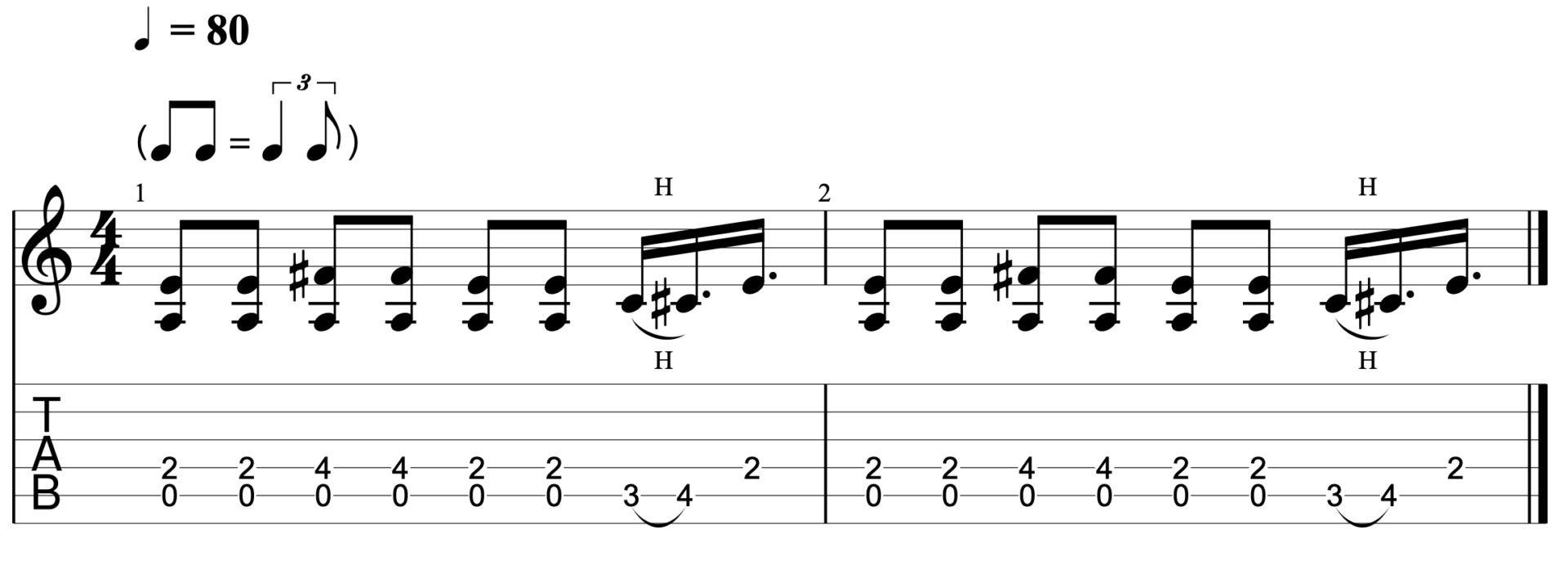
And at 80 BPM (beats per minute), this is what it sounds like:
If you read my last article on the basic forms of the shuffle, you may have noticed that here the shuffle is played in a different section of the guitar, even though it is also in the key of A.
This is because it makes sense to play this variation in the open position on your guitar, as the shapes above are compact and easy to play.
That is not to say though that you can’t play these shapes in different parts of the neck to achieve a different sound and feel. And I’ll go into more detail on this below.
Regardless of how you choose to play this variation though, we can apply a similar idea to the ‘riff-based shuffle’.
Sticking at 80 BPM in the key of A, this is what this variation looks like:
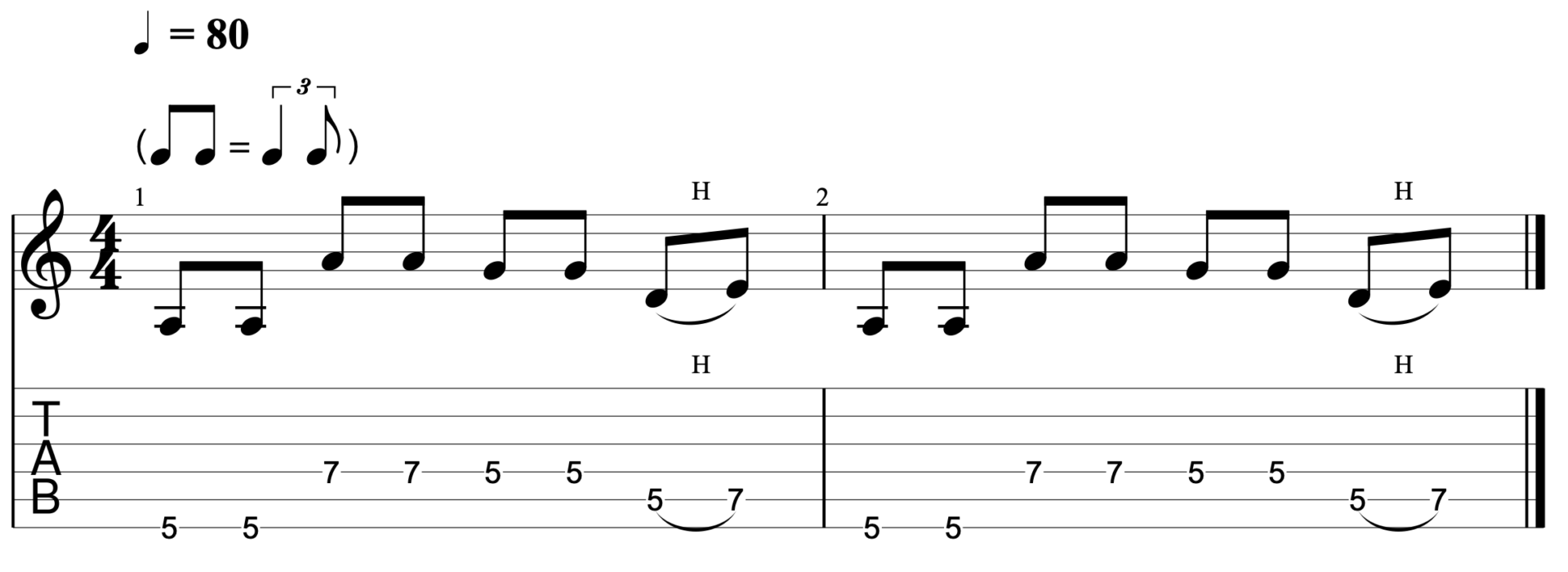
And at 80 BPM it sounds like this:
In both of these examples, you can hopefully hear the difference that just adding these short fills makes.
It makes the whole pattern sound smoother and less rigid, which brings a different feel to the shuffle.
2.) Rock & Roll
This next variation was used to great effect by Led Zeppelin in their song, ‘Rock and Roll’. It is a very simple variation and is best applied to the classic shuffle pattern.
Here is what it looks like in the key of A:

And at 80 BPM it sounds like this:
This variation is a great one to learn, as it is particularly versatile and responsive to your playing style.
You can totally alter how this pattern sounds and the feel of the shuffle by changing the way you strum your guitar and the way you attack each of the notes.
I have added in more detail on this below.
3.) Get bluesy
On the other side of the spectrum, you can add a totally different feel to a shuffle by utilising chromatics and adding the ‘blue note’ into the shuffle pattern. This works particularly well with the riff-based shuffle.
This is what this example looks like in the key of A:
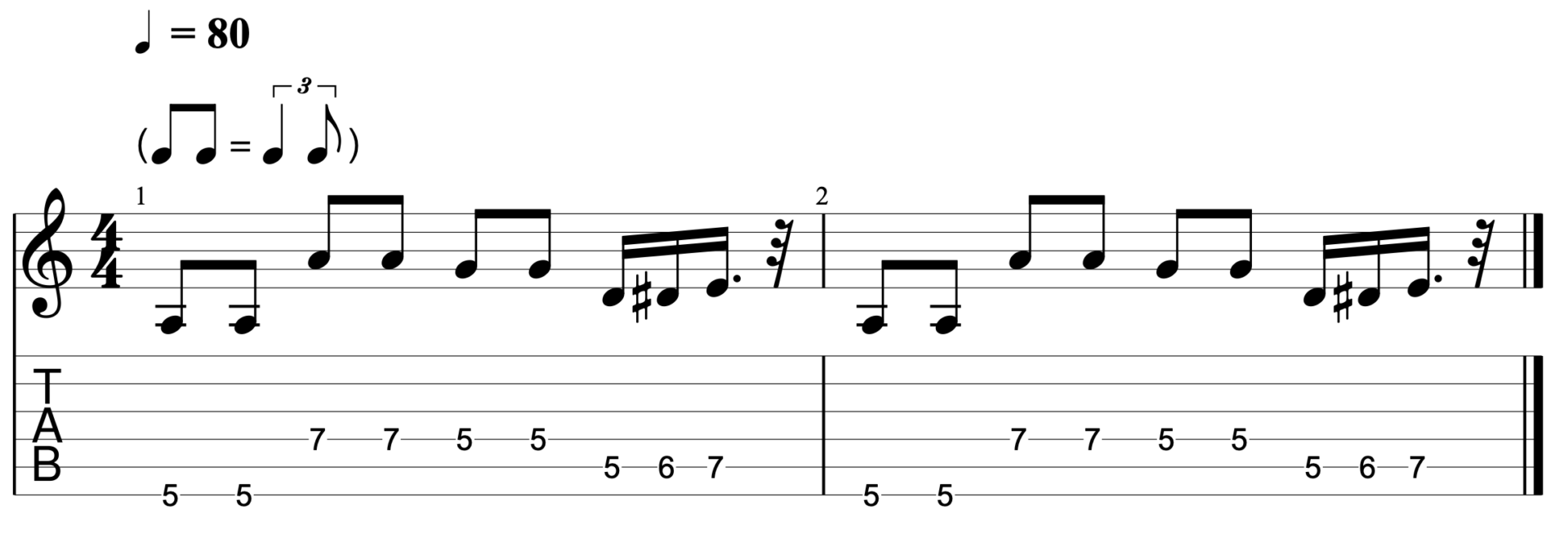
And at 80 BPM it sounds like this:
Chromatics add dissonance and can alter the whole vibe of a piece.
So use them sparingly, as they don’t always work well. When they do, they sounds great.
Experiment with where and when to use them until you find what works best.
4.) Articulate
In all of the audio examples here and in my last article, the guitar part is played with palm muting. There are a few reasons for this.
Firstly, it works for these demonstrations, as you can hear each of the notes more clearly because they don’t run into one another.
More importantly though, palm muting creates a tight sound that works well for rhythm playing, and sounds great for the blues.
You don’t need to play like this all of the time though. In fact you can and should alter the feel and vibe of a shuffle by changing your articulation.
You can palm mute and play each note in a very clipped and staccato way. Or you can let the notes ring out for a looser feel.
It might sound simple, but altering your articulation makes a big difference to how a shuffle sounds.
Just listen to the following examples, where we compare a shuffle pattern that is played with muted strings, with one where the notes ring out.
Let’s look again at the notes that appeared in variation 2 (above):

Now though, listen to 4 bars of this variation.
Here the first 2 bars are played as they were in the previous example. The guitar is played with muted strings.
The second 2 bars are altered, and are played with the notes ringing out:
As you can hear, there is a real difference between the first 2 bars and the second 2 bars.
Even though the notes are exactly the same, the feel of the shuffle is very different.
So don’t just focus on the notes you are playing.
Think about how you play them too, as this will make a massive difference to the quality of your rhythm playing.
5.) Be dynamic
In addition to the previous point, it is also important to focus on your dynamics.
Not only can this totally alter the feel and groove of a piece, but it is a skill you need to learn if you want to play certain styles of the blues shuffle.
Let’s take the ‘Texas Shuffle’ as an example.
Best associated with Stevie Ray Vaughan, this style of shuffle places a lot of emphasis on the third note in each triplet group. And this really alters the sound of the shuffle.
Let’s look again at the same notes as above:
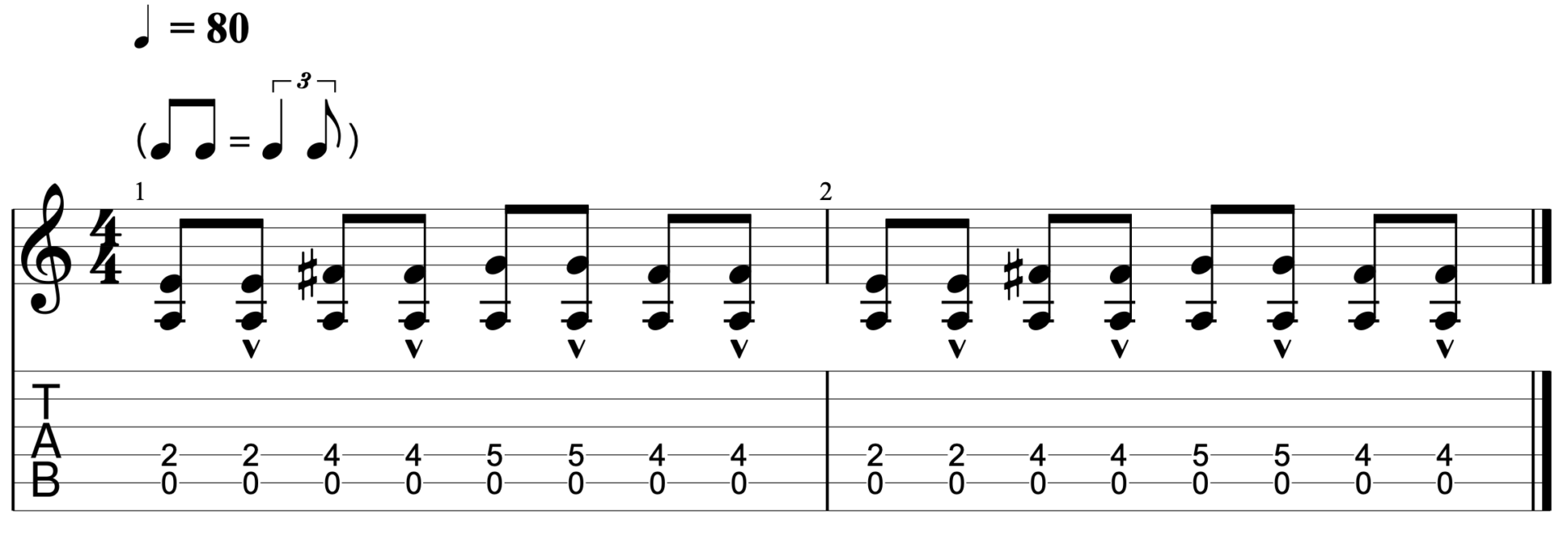
Now though, listen to 4 bars of this variation.
Here the first 2 bars are played in the style of the Texas shuffle, with emphasis placed on the third note in each triplet grouping.
The second 2 bars are played as they were before, with all of the notes played evenly.
I have somewhat exaggerated the differences in the dynamics here to illustrate the point.
But even if the differences were not so pronounced, you would be able to hear that even though the notes used across the 4 bars are exactly the same, the feel of the shuffle changes dramatically when emphasis is placed on particular notes.
This emphasis is highlighted on the notation above by the ‘v‘ signs above the accented notes.
6.) Mix & match
One easy way of adding variety to a shuffle is to alter the pitch at which you play.
This alters the feel quite dramatically and provides you with a whole multitude of different ways to play the shuffle, without having to learn any new phrases.
Let’s look at this variation in the final 4 bars of a 12 bar blues progression in A:
Example 1
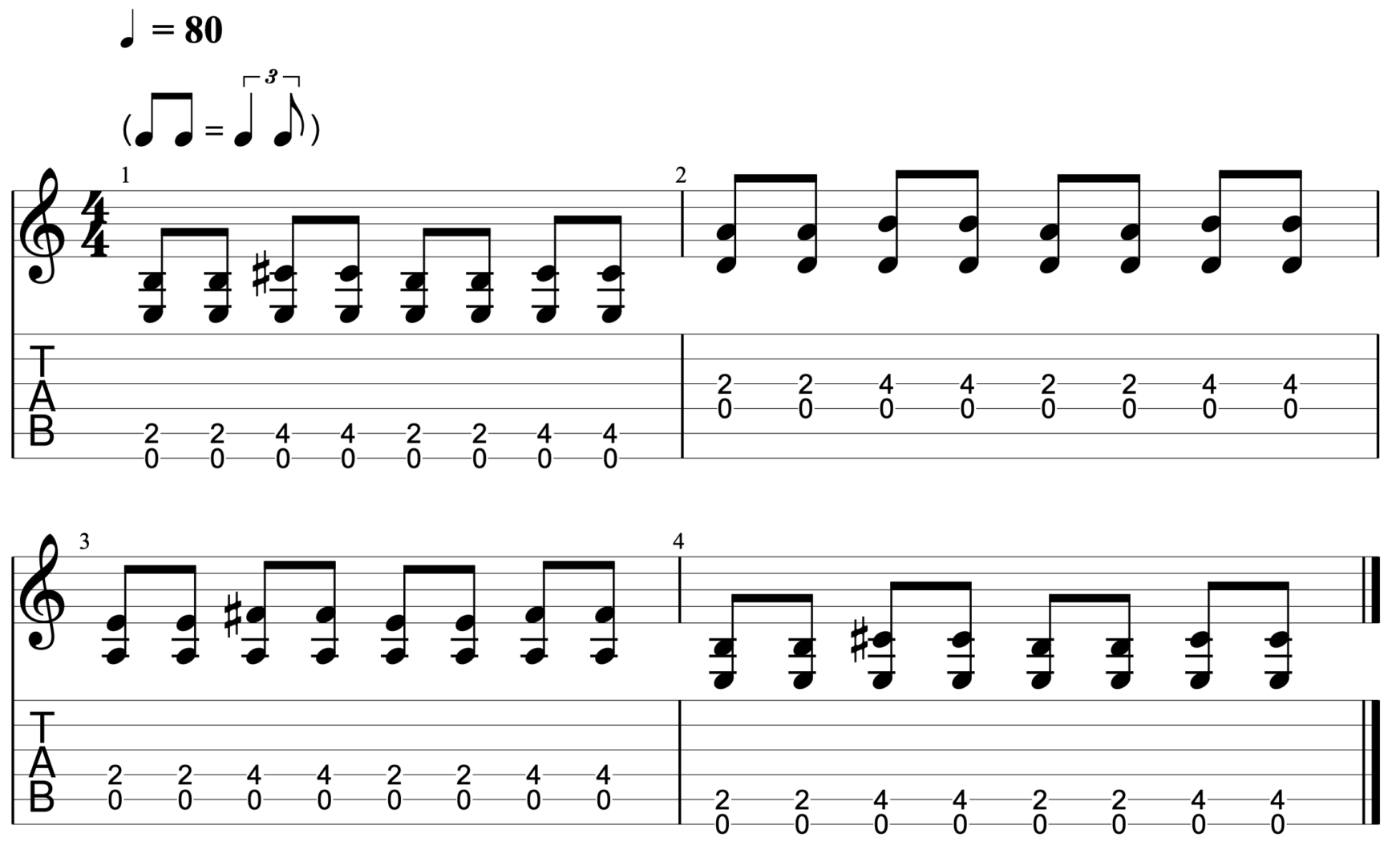
This is probably one of the most common ways that guitarists play this turnaround section. Here the V chord of the progression (an E in the key of A), is played on the low E string.
At 80 BPM, this is what it sounds like:
It sounds brilliant, and authentically bluesy. However you can change the feel of this section by shifting the V chord up an octave.
This is what the same turnaround section looks like when played in that way:
Example 2
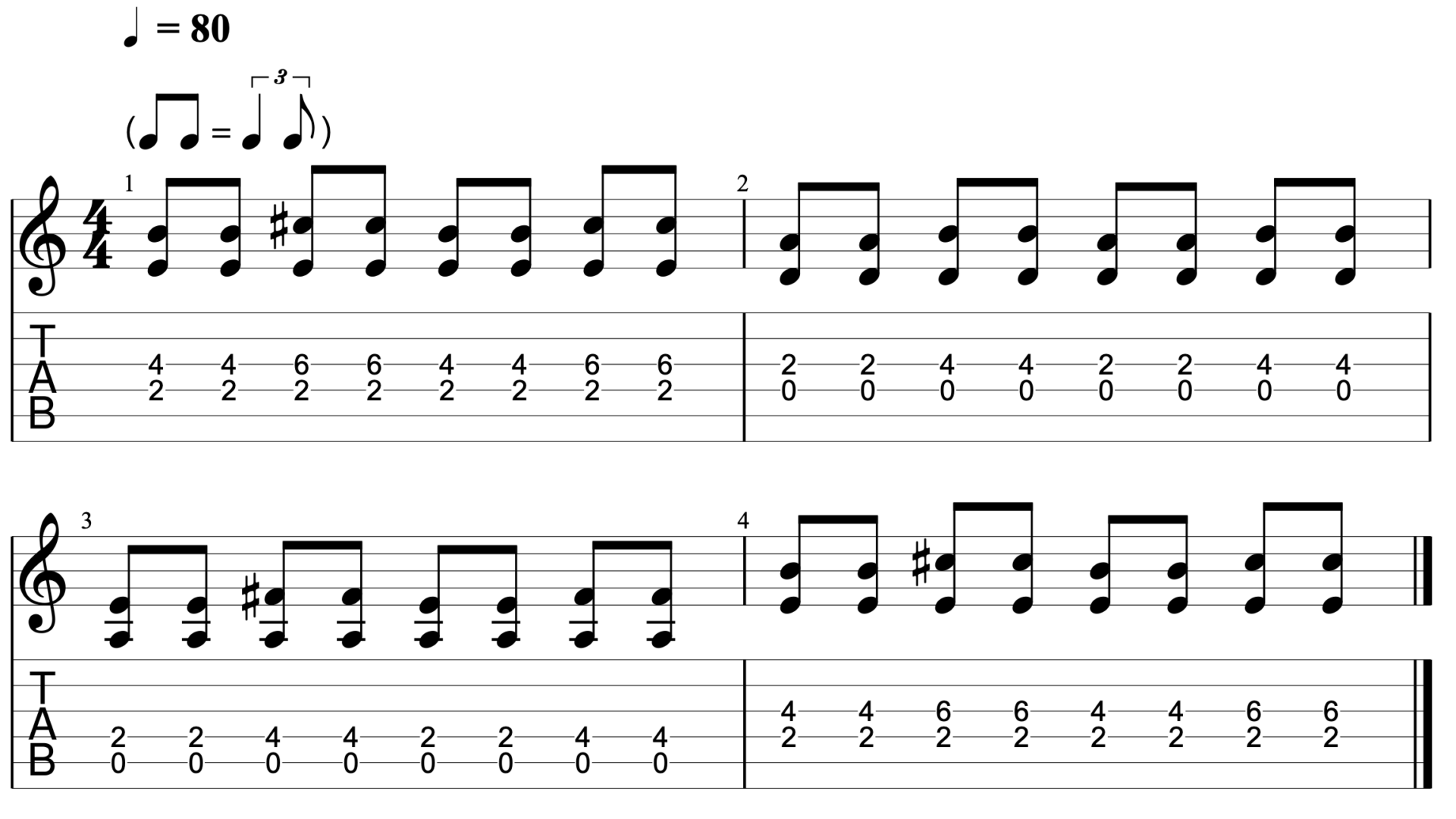
And at 80 BPM, this is what this section sounds like when you play the V chord an octave higher:
There are innumerable ways that you can utilise this variation.
It doesn’t necessarily have to be the V chord that you change. Alternatively you could play around with where you play some of the other chords in the progression too.
The voicings you use will depend on the song you are playing, the singer you are backing, and the feel you want to create.
Play around and experiment with playing the shuffle pattern all over your guitar and seeing what works best for you.
Putting it all together
We can take all of these ideas and put them together over the course of a 12 bar blues to create a much more interesting blues shuffle.
Sticking in the key of A, this is just one example of how you can combine these ideas to bring life to a basic shuffle pattern.
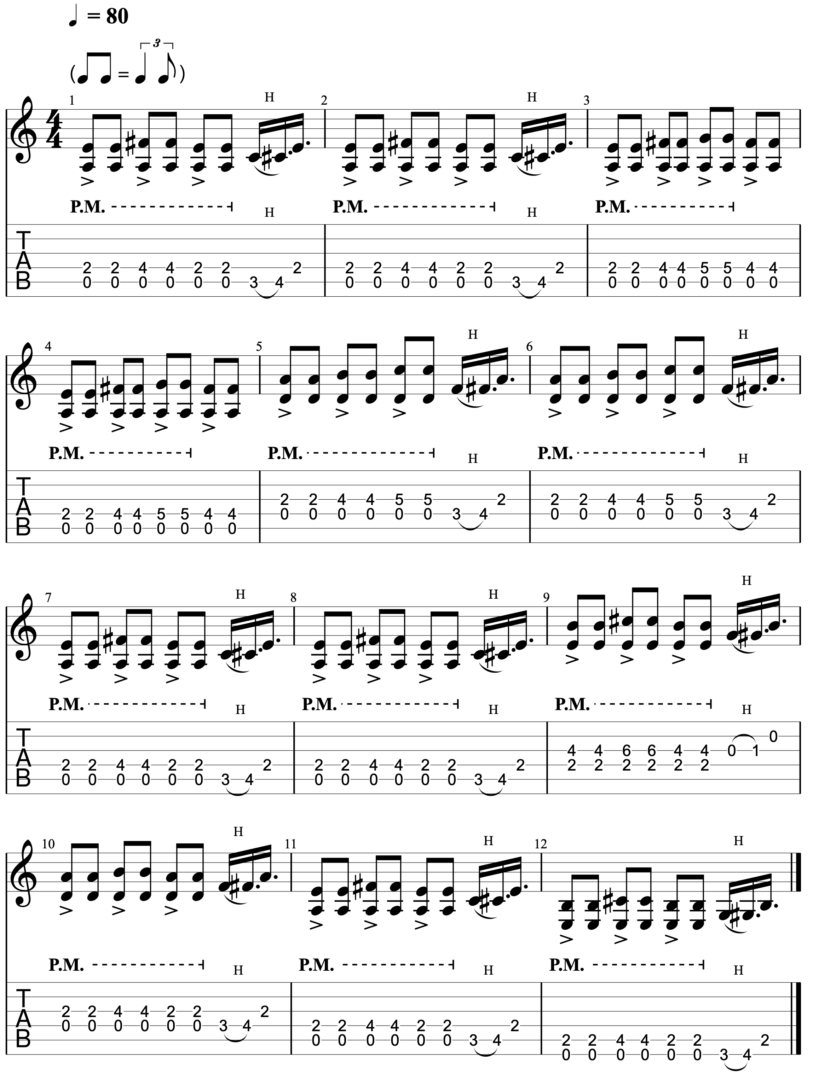
This is what it sounds like:
Here I am utilising all of the techniques mentioned in this article.
Hopefully you can see how this helps you to get a lot more mileage out of a pretty simple set of notes.
In practice, I wouldn’t recommend using all of these techniques within one shuffle.
There are certain parts of this shuffle – particularly playing the V chord in two different positions within the same 12 bars – that makes the pattern sound a bit busy.
You have to remember that the shuffle is rarely played as a solo or lead section.
You are there as part of a band and to support a singer, so you don’t want to constantly be reinventing what you are playing, trying to stand out from the mix.
Instead, you want to develop a solid collection of riffs, fills and tricks that you can rely on to add life to your rhythm playing and keep it interesting.
Well, that’s it for today. I hope that the tips here help you to get you started and improve the quality of your rhythm playing 😁
Do you have any more tricks that you like to use when you play the blues shuffle? Please share them in the comments if so, I’d love to hear them!
Images
References
Guitar World, Best Blues Guitar Lessons Online, Guitar Habits, Youtube





Responses
You need a YouTube channel. That is where the money is!
Haha thanks very much Ken! I think you’re right and it’s definitely in the pipeline 😁 If you have any particular topics you’d like me to cover for when the day comes, or if there is anything else I can help with, just send me an email on aidan@happybluesman. Thanks so much!